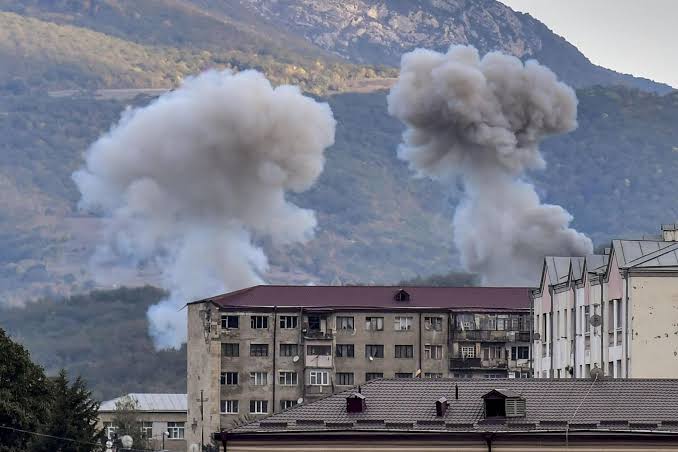The clashes, the worst since a 1994 ceasefire, have sparked fears of a regional conflict with Turkey backing Azerbaijan, Armenia seeking to pull ex-Soviet ally Russia in on its side and Iran looking on warily.
After 11 hours of talks between the Armenian and Azerbaijani foreign ministers in Moscow, the two sides agreed early Saturday to a humanitarian ceasefire.
Read Also: Italy Crush Armenia 9-1 To Perfect Euro 2020 Qualifying
Thumping echoes of shelling
But repeated clashes have so far made a mockery of the truce deal.
An AFP correspondent in the Azerbaijani town of Barda not far from the front line heard thumping echoes of shelling Monday morning.
In Karabakh’s main city of Stepanakert, an AFP photographer heard the sounds of shelling from the direction of the town of Hadrut.
“Armenian armed forces, which did not comply with the humanitarian truce, repeatedly tried to attack the positions of the Azerbaijan army,” the Azerbaijani defence ministry said.
It said it had destroyed a “large number of enemy forces” as well as one T-72 tank and three Grad multiple rocket launchers.
Armenian defence ministry spokeswoman Shushan Stepanyan said for her part that Azerbaijan was “now intensively shelling the southern front”.
Armenia claimed that “the adversary suffered great losses of manpower and military equipment” but did not provide further details.
The 1990s war — which ended with the 1994 ceasefire that did not present a long-term solution to the conflict — resulted in the deaths of about 30,000 people.
Nearly 500 people including more than 60 civilians, have been killed in the latest fighting since last month, according to a tally based on tolls given by both sides.
The ceasefire negotiated in Moscow had agreed to pause hostilities to exchange prisoners and the bodies of people killed, with Azerbaijani officials insisting it was only going to be a temporary measure that would not halt its campaign.
‘Continued military activities’
Analysts have long warned that Nagorno-Karabakh was the most combustible of the frozen conflicts left over after the fall of the Soviet Union, with Azerbaijan vowing to regain control of the territory and Armenians insisting they would never cede ground.
The EU’s diplomatic chief Josep Borrell said on Sunday he was concerned by “reports of continued military activities, including against civilian targets, as well as civilian casualties” in violation of the ceasefire.
The so far fruitless decades-long search for a settlement over Karabakh has been overseen by the Minsk Group of world and regional powers chaired by France, Russia and the United States.
Armenian Foreign Minister Zohrab Mnatsakanyan was in Moscow on Monday for a visit including meetings with the Minsk Group co-chairs as well as Russian Foreign Minister Sergei Lavrov.
Lavrov lamented at the start of the talks that the ceasefire “was not being fully observed” with fighting continuing. He expressed hope that talks with both sides would allow “the full implementation” of the agreements made in Moscow last week.
Renewed fighting has stoked fears of a full-blown war embroiling Turkey, which strongly backs Azerbaijan and has been accused by Paris and Moscow of sending pro-Ankara Syrian militiamen to help Baku.
Russia, meanwhile, has a military base in Armenia and counts Yerevan as an ally in the Moscow-led Collective Security Treaty Organisation (CSTO).
However the Kremlin has kept its distance from Armenian encouragement to become involved, saying that the CSTO treaty does not extend to Karabakh.
Iran, which has warm relations with Armenia and is wary of Baku’s military cooperation with Israel, has also expressed alarm over the reports of Syrian militia being sent to Azerbaijan.
In a statement, the Iranian foreign ministry expressed regret “over the violation of the announced ceasefire”, urging both sides to resume talks.
AFP
